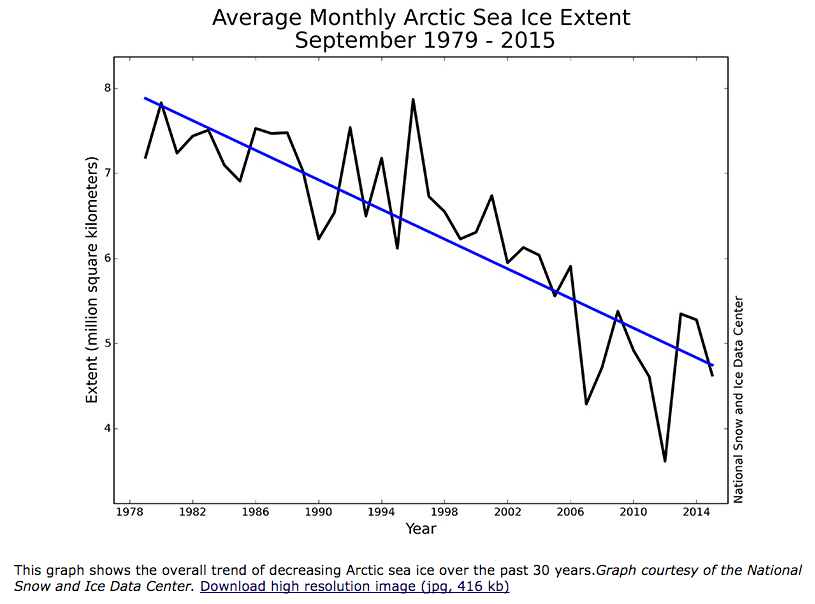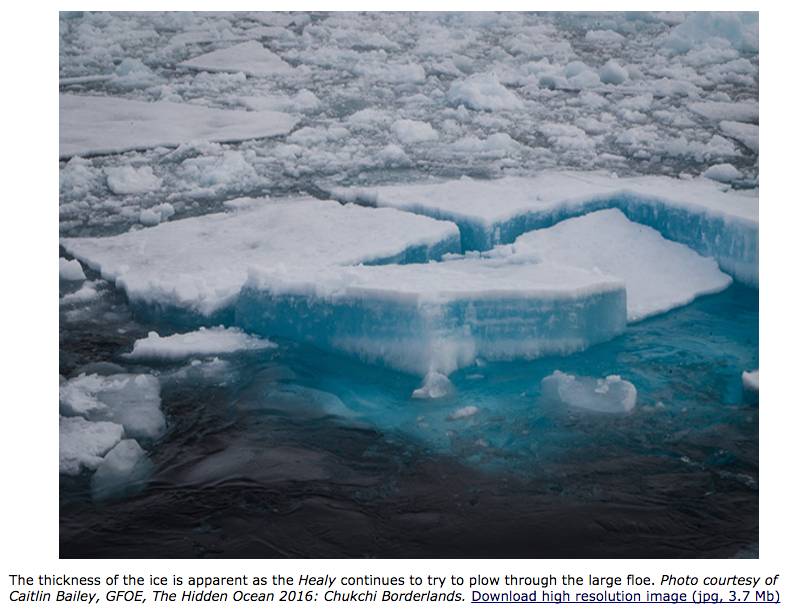[iframe id=”https://www.facebook.com/plugins/video.php?href=https%3A%2F%2Fwww.facebook.com%2FOceanExplorationResearch%2Fvideos%2F915788555191171%2F&show_text=0&width=400″]
“Despite reports of declining ice cover in the Arctic, the Chukchi Borderlands expedition team quickly learned that ‘low ice coverage’ does not mean ‘no ice coverage,’ as the Chukchi Sea is currently a mosaic of ice floes and open water that has been a challenge to break through.
In this video, the U.S. Coast Guard Cutter Healy moves through multi-year ice using an “ice knife” on the bow that was specially designed to cut into and break ice.” – NOAA, today

July 12, 2016
by Kate Segarra
Bureau of Ocean Energy Management
Expedition Coordinator
In the months leading up to this expedition, news was circulated that 2016 is on track to set a new minimum for sea ice in the Arctic. We were all concerned about these predictions and the implications for both the ecology of the Chukchi Sea as well as the impacts on our science mission. Sea ice in the Arctic reaches a minimum at the end of the melting season in September. The lowest Arctic sea ice minimum occurred in 2012. According to the National Snow and Ice Data Center, September sea ice extent declined 13.4 percent per decade between 1979 and 2015. However, low ice coverage does not mean no ice coverage and the Chukchi Sea is currently a mosaic of ice floes and open water.

In ice this thick, the going is slow. Very slow. The ship uses the ice knife and also rafts up onto the ice, which momentarily holds the weight of the ship before giving way to the tons of steel above it. TheHealy then backs up a ship-length or two and uses this cleared space to build up momentum and ram the ice again. It’s an impressive process to see from the bow, and perhaps even more impressive to hear as the ice scrapes along the hull, creaking and groaning as it breaks.
On Saturday (July 9) evening, the entire ship rattled and shook as the Healy cut through multi-year ice that was over 4 meters (14 feet) thick in some places. We were not sure how long it would take us to travel the 20 or so nautical miles to our first station given the ice coverage, but it was expected we’d be at our first station around noon the next day. We all went to sleep lulled by sounds of ice meeting steel and excited by the thought that after days of transit we would finally be collecting samples!
In the science lab, there is a white board which displays the plan of the day. This board is known as the ‘Board of Lies,’ thus called because things at sea don’t always go according to plan. Our plan of the day on Monday changed from having a look around the Arctic benthos with the remotely operated vehicle to waiting.
The Healy was slowly breaking its way through a giant ice floe. Visibility was poor and the satellite ice imagery the crew relies upon for navigation is only updated once a day. To complicate matters, the ice floe was being pushed and rotated by the Beaufort Gyre, a wind-driven, clockwise current in the Arctic Ocean. At the pace the Healy was breaking ice (less than one mile per hour) we were drifting with the floe faster than we were traveling through it.
We spent that day and the next two days plowing through a terrain of ice and scattered melt ponds. It is now Tuesday, July 12 and we are still in the ice floe. Our escape is imminent – we can see the open water just a few miles ahead of us!
While we are frustrated by the delay this ice has caused us, the past few days have been full of wonder and beauty. We have seen polar bears and seals (see Kate Stafford’s log here). It also afforded the expedition’s first opportunity for some ice operations (a log entry about ice-based research is coming soon). Being ice-bound for four days has also built camaraderie amongst the science party. Our ice floe feels like another planet inhabited by only polar bears, seals, and the 141 of us aboard the Healy.
